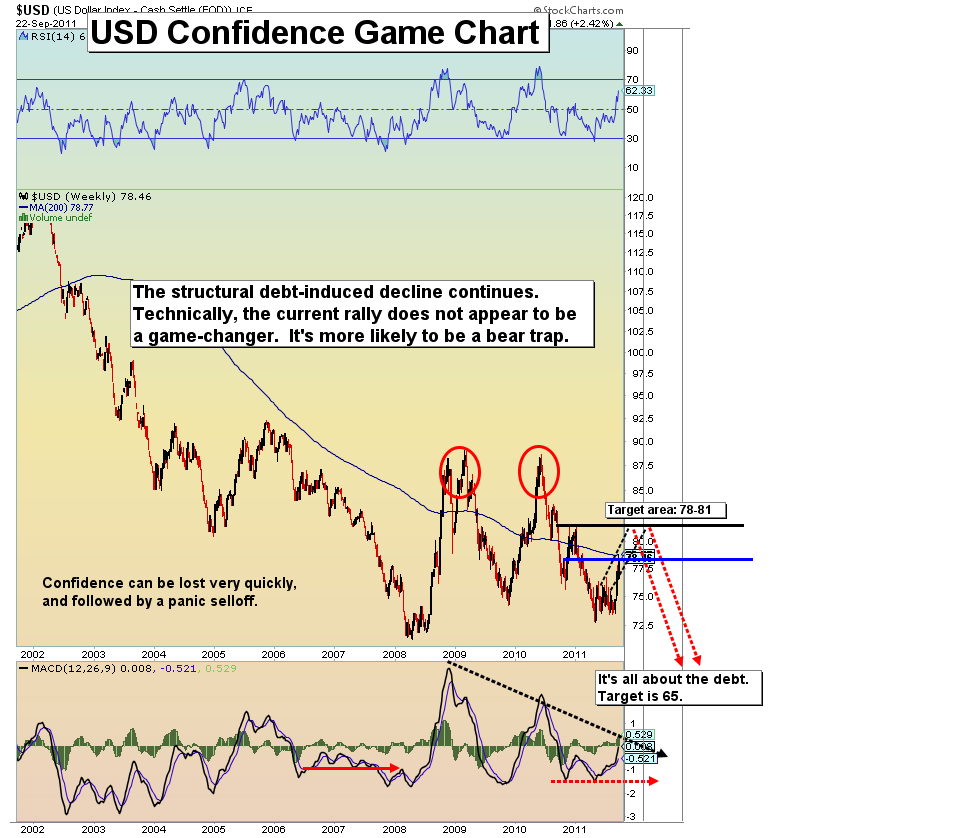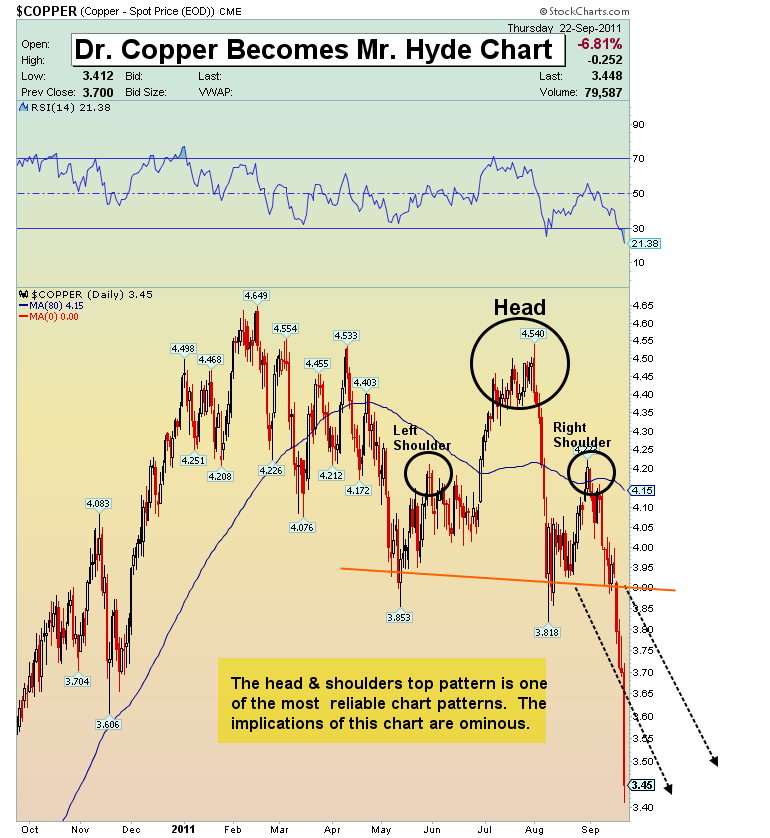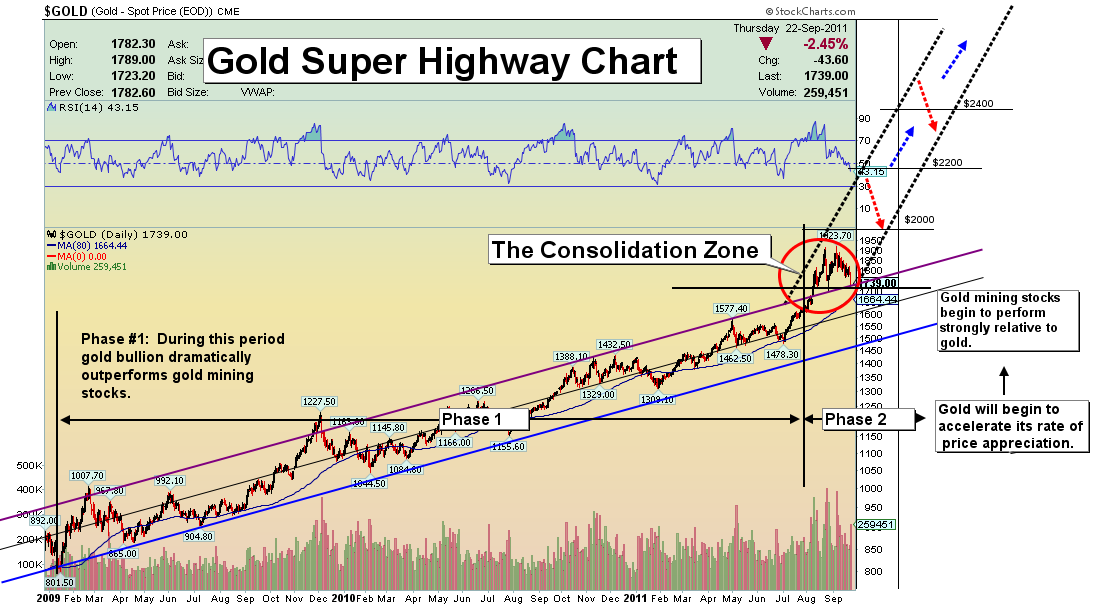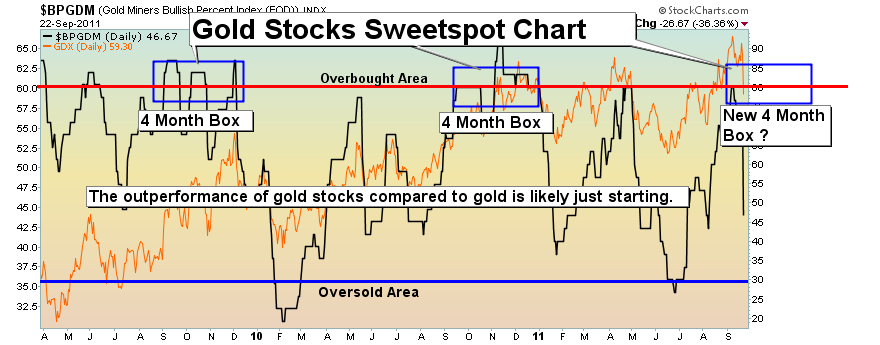Ein bankrotter Uncle Sam belehrt scheinheilig Europa über Schulden.
http://www.forbes.com/sites/dougbandow/2011/09/26/a-bankrupt-uncle-sam-hypocritically-lectures-europe-on-debt/2/
A Bankrupt Uncle Sam Hypocritically Lectures Europe On Debt
Uncle Sam should declare bankruptcy. The government faces debts and unfunded liabilities on the order of $211 trillion, according to economist Laurence Kotlikoff. That’s about 15 times America’s official national debt—and GDP. Yet the Obama administration continues to lecture the rest of the world on how to get its economic house in order.
Europe’s worsening debt crisis, highlighted by the threat of default by Greece, was the top topic as finance ministers from around the world gathered in Washington for the annual International Monetary Fund meeting. Despite frantic European efforts to prop up the Athens government’s finances, investors have been fleeing to safer investments, driving German bond yields down to record lows. European governments remain divided, lacking answers and time.
President Barack Obama has been pressing European leaders, most importantly German Chancellor Angela Merkel, to follow his profligate policies in the U.S. Treasury Secretary Timothy Geithner even attended the recent European Union summit on the continent’s economic crisis to lobby his counterparts.
Geithner gave his hosts the benefit of his thinking whether they wanted it or not. Some did not. Maria Fekter, Austria’s finance minister, noted archly: “I found it peculiar that even though the Americans have significantly worse fundamental data than the Euro zone that they tell us what we should do.” Jean-Claude Juncker, both prime minister and finance minister of Luxembourg, declared: “We are not discussing the expansion or increase of the [financial stability fund] with a non-member of the Euro area.”
To be fair, the administration was not without something to say. But any advice should have been what not to do.
Don’t engage in counter-productive, large-scale bail-outs. Don’t waste hundreds of billions of dollars on ineffective “stimulus” programs. Don’t initiate massive new regulatory programs that create expense and uncertainty without addressing the most important causes of the last crisis. Don’t put off tough budget decisions involving domestic entitlements and military outlays.
However, that’s not what Secretary Geithner said. True, he admitted that “we’re not in a particularly strong position to provide advice to all of you.” But that didn’t stop him from doing so.
He warned of “catastrophic risk,” as if his European counterparts were blind and deaf. He insisted that “the big countries in Europe, the leaders in Europe must meet and take a decision on how to coordinate monetary integration with more effective coordinated fiscal policy,” as if the EU was a centralized nation state like America.
He told the other participants to act “decisively” even though the administration in which he serves has failed to address this country’s toughest spending issues. He urged the EU members to stimulate their individual economies and expand their continental bail-out fund, even though the Obama administration’s comparable domestic efforts have failed. The Europeans have the capacity to deal with their problems, he declared: they “just have to choose to do it.” As Americans have not done.
The Europeans face severe economic difficulties. Successive bail-outs increasingly seem unlikely to prevent default by Greece, which would threaten banks across the continent, including in Germany, heretofore Europe’s growth engine. Some investors worry about a reprise of the 2008 financial crisis.
A Bankrupt Uncle Sam Hypocritically Lectures Europe On Debt
Page 2 of 3
Contagion threatens to spread well beyond Greece: Ireland and Portugal already have collected a hand-out from their European brethren. Worse, Spain and Italy, with far larger economies, face uncertain futures.
EU heavyweights, like President Obama, have lined up to demand that Chancellor Merkel show “bold leadership”—meaning commit more of her countrymen’s money to prop up Europe’s most improvident states. However, German citizens have begun to shout Nein! A majority wants to abandon their spendthrift friends and bring back the hallowed Deutsch Mark.
The normally sober Economist magazine declared that she just “needs to explain to her people” that the alternatives are worse. But even the fabled German economy can’t forever underwrite the rest of Europe. No wonder Germans are worried, punishing Angela Merkel’s governing coalition in regional elections despite a growing economy.
Nevertheless, so far the Eurocratic elite, a motley collection of politicians, bureaucrats, journalists, businessmen, and academics which dominates the European Union, is determined to save the Euro zone by strengthening continental control over national budget and economic policy. In essence, this group is hoping to create a Europe more akin to that of the United States, a quasi-nation state which will take its place as a Weltmacht alongside America and China.
There’s nothing wrong in principle with such an ambition—except for the fact that no one in Europe other than the Eurocrats wants to turn Brussels into Washington. Most Europeans, at least the ones working, paying taxes, and suffering under the EU’s regulatory dictates, are either indifferent or strongly opposed to further continental centralization.
Indeed, the only way EU leaders were able to win ratification of the so-called Lisbon Treaty, which further concentrated political authority in Brussels and created a European president and foreign minister, was to press the Irish to vote twice, after they defeated the agreement the first time, and prevent anyone else from voting. Polls indicated that citizens in half of the EU countries would have rejected the treaty if given a chance.
Today expanding Brussels’ authority over national budgets faces resolute opposition, including from many governments. Yet without a more unified European fiscal policy, the Eurozone—to which 17 of the 27 EU members belong—could shrink, if not collapse. The costs of a messy economic divorce likely would be huge.
Europe’s total debt to GDP is around 80%, but several nations have more serious problems. As of last year Greece’s ratio hit 143%. Italy’s was 119%. The debt ratios for Belgium, Ireland, and Portugal all exceeded 90%. Other countries like Great Britain are making painful budget cuts to avoid their own debt crises.
There are no easy answers. Nor are there any painless ones. Who should pay for whom? Who should have political authority over whom? Certainly the U.S. has no answers. Washington should offer Europe good wishes and little more.
There’s an even better reason for U.S. officials to shut up. They have no credibility to instruct the Europeans. Maria Fekter observed: “I had expected that, when [Secretary Geithner] tells us how he sees the world, that he would listen to what we have to say.”
First, the U.S. has struggled with the issue of political centralization even though the American colonies shared a common culture, fought a war together to win their independence, and only once battled among themselves. Even today, political centralization remains controversial—for good reason, given Washington’s many manifest policy failures.
Second, the U.S. has an abysmal fiscal record. Total federal debt, which includes “loans” from the Social Security Administration to the Treasury Department, approaches 100% of GDP. These intra-government debts are artificial, but over time their “redemption” as the government pays Social Security benefits will add to the publicly held debt, which accounts for about 67% of GDP today.
Page 3 of 3
Moreover, the U.S. has its irresponsible states which don’t know how to say no. In terms of debt/GDP, Massachusetts leads the pack, at 20.43% (2009 figures). Rhode Island follows at 19.19%. Despite its oil wealth, Alaska is at 14.42%. Supposedly frugal New Hampshire is at 14.16%. Vermont is at 13.47%. Montana stands at 13.25%. Connecticut comes in at 12.49%.
In recent years California has made a practice of borrowing to fund its profligacy. Its debt/GDP ratio is “only” 7.12%, but $134.6 billion in official debt is supplemented by $62.4 billion in unfunded health care and other liabilities and $59.5 billion in unfunded public pensions. Illinois has $57 billion in debts and, following Washington’s lead in creating unfunded liabilities, another $54.4 billion in unfunded public pensions. New York suffers from a debt/GDP ratio of 11.22%; its $122.7 billion in official debt is augmented by $56.3 billion in unfunded health care and other liabilities.
Neither Republicans nor Democrats offer real solutions. This year’s vaunted budget deal focused on domestic discretionary spending, yet these outlays make up only about 15% of the federal budget. Democrats hate cutting even these programs, while Republicans bridle at proposals to simply slow the growth of military outlays. And no one wants to take on the great budget boulders, Social Security, Medicare, and Medicaid.
The Congressional Budget Office sees only more red ink and debt. The most positive alternative fiscal path is merely horrible. According to CBO: “Even with declining deficits, debt held by the public would continue to grow in the near term relative to the size of the economy—from 67% of GDP this year to a peak of 73% by the end of 2013. After that, debt held by the public would gradually fall to 61% of GDP by 2021, an amount well above the annual average of 37% recorded over the past 40 years.”
That’s not all. “That substantial debt, coupled with rising interest rates, is projected to cause the government’s annual net spending for interest to nearly double as a percentage of GDP between 2011 and 2021.” Worse, so-called “mandatory” spending will continue to increase. In the next few years other spending, such as unemployment compensation, is expected to drop (assuming Congress doesn’t up outlays, as it has in the past), helping to mask the impact of the entitlements increase. But in the latter years of this period, “rising spending on those health care and entitlement programs will cause mandatory outlays to increase again at a faster rate than the economy.”
That is, Social Security, Medicare, and Medicaid will continue racing upward, threatening to swamp the rest of spending. Or as CBO put it: “the aging of the population and rising costs for health care would almost certainly push federal spending up sharply relative to GDP after 2021 if current laws remained in effect.” This is supposed to be the good news!
The more realistic scenario is frightening. Simply assume that Congress does what Congress normally does: refuse to make hard decisions and retreat from any hard decisions it made in the past. If “revenues remained near their historical average of 18% of GDP” while spending increased as past experience suggests, noted CBO, “debt held by the public would balloon to nearly 190% of GDP by 2035. Although new long-term projections reflecting the latest 10-year projections would differ, the amounts of federal borrowing that would be required under those policy assumptions clearly would be unsustainable.”
Indeed, such a fiscal policy would shrink the economy. Economist Carmen Reinhart warned Congress last year that “across both advanced countries and emerging markets, high debt/GDP levels (90% and above) are associated with notably lower growth outcomes.”
The CBO similarly predicted that “Large budget deficits and growing debt would reduce national saving, thus leading to higher interest rates, more borrowing from abroad, and less domestic investment—which in turn would lower real GDP and income in the United States relative to what would otherwise occur. Furthermore, paying for the rising costs of interest through higher marginal tax rates could discourage work and saving and reduce output even more.” Finally, such a debt increase “would boost the probability of a sudden fiscal crisis, during which investors would lose confidence in the government’s ability to borrow at affordable rates.”
America’s debt crisis is not a partisan issue. George W. Bush and his GOP congressional allies were extraordinary wastrals, upping federal outlays on most everything. His Medicare drug benefit was almost as large a budget-buster as was President Obama’s health care “reform” bill. During the financial crisis the Bush administration encouraged the presumption that everyone everywhere would be bailed out for everything. The national debt doubled on President Bush’s watch.
However, President Obama has turned out to be even worse. The bail-outs continued, money was wasted on ineffective economic “stimulus,” welfare reforms were abandoned, and an expensive new entitlement, subsidized health insurance, was created. Each new budget has forecast higher outlays, debt, and interest payments. The administration pressed for “financial reform” while ignoring the epicenter of the 2008 disaster, Fannie Mae and Freddie Mac, which degraded lending standards and securitized bad mortgages. These two bodies are still operating, losing ever more money.
And the administration, obviously oblivious to its own failures, now is pushing the same policies overseas. It’s unfortunate for Americans that the Obama administration has learned so little from its experience over the last three years. It’s unfortunate for people elsewhere that the denizens of Washington believe themselves qualified to lecture the rest of the world.










